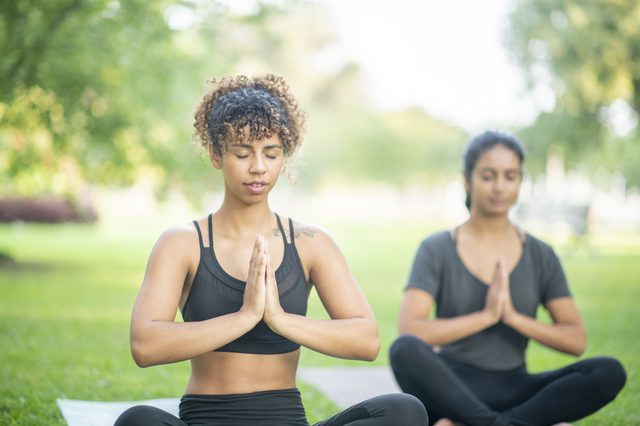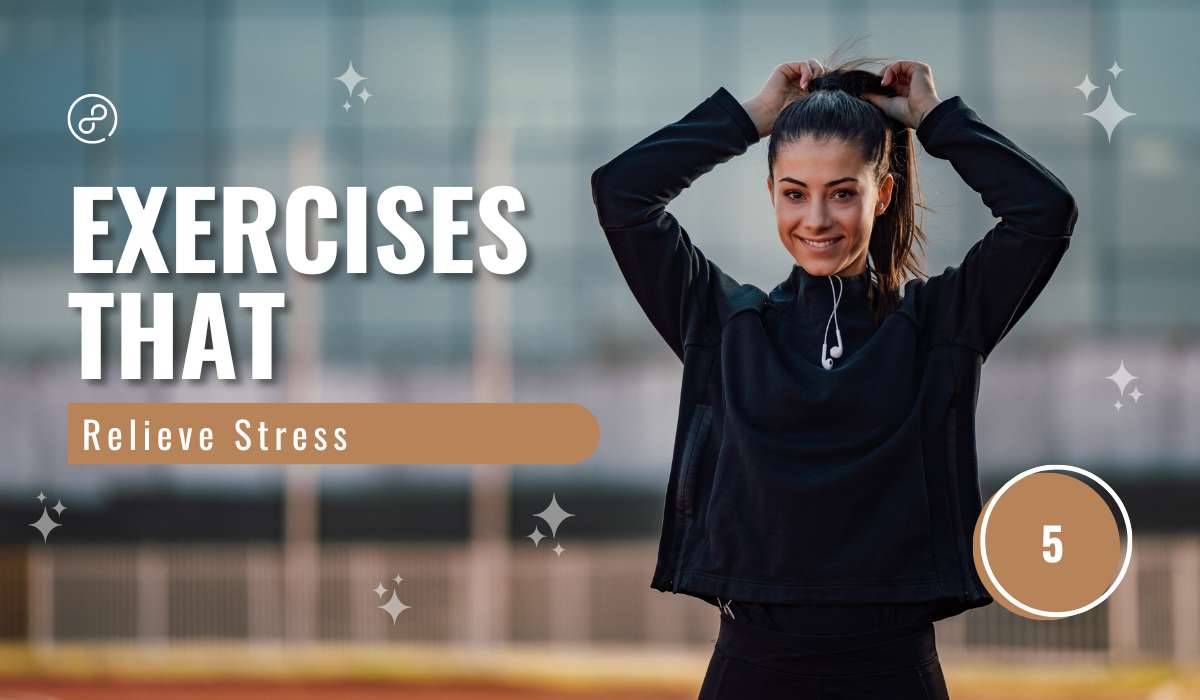Exercises That Relieve Stress, stress has become a common part of our lives, affecting our mental and physical well-being. Fortunately, there are various exercises that can help relieve stress and promote relaxation. From yoga and meditation to deep breathing exercises and progressive muscle relaxation, incorporating these techniques into your daily routine can provide much-needed relief from stress. In this article, we will explore eight exercises that can effectively alleviate stress and help you find inner peace. So let’s get started!
Yoga

Yoga is a powerful exercise for relieving stress, promoting relaxation, and improving overall well-being. Here are some yoga poses that can help reduce stress: Child’s Pose, Cat-Cow Pose, Standing Forward Bend, Bridge Pose, Legs-Up-the-Wall Pose. Practicing these poses regularly can enhance flexibility, release tension in the body, and calm the mind. The benefits of yoga for relaxation include increased mindfulness, reduced anxiety, and improved sleep quality. Incorporate these poses into your daily routine to experience the soothing effects of yoga on stress levels.
Yoga Poses for Exercises That Relieve Stress
Yoga Poses for Stress Relief:
1. Child’s Pose: Kneel on the floor, touch your forehead to the ground, and extend your arms forward. Breathe deeply and relax.
2. Cat-Cow Pose: Get on all fours, arch your back and drop your head, then lift your head and curve your spine. Repeat several times.
3. Standing Forward Bend: Stand with your feet hip-width apart, bend forward at the hips, and let your upper body hang relaxed.
4. Bridge Pose: Lie on your back with knees bent and feet flat on the ground, lift your hips off the floor, and interlace your fingers under your lower back.
5. Legs-Up-the-Wall Pose: Lie on your back with your legs extended up against a wall, relax and breathe deeply.
Incorporating these yoga poses into your routine can help release tension in the body and promote relaxation for overall stress relief.
Benefits of Yoga for Relaxation
Yoga has numerous benefits for relaxation, including reducing stress, promoting mindfulness, and improving overall well-being. It helps calm the nervous system, lowers blood pressure, and releases tension in the body. Regular practice of yoga can also improve sleep quality, increase flexibility, and enhance mood. By incorporating yoga into your routine, you can experience the physical, mental, and emotional benefits it offers for stress relief.
Meditation

Different meditation techniques can be used for stress relief, such as mindfulness meditation, loving-kindness meditation, and transcendental meditation. To practice mindfulness meditation, find a quiet space, sit comfortably, and focus on your breath or a specific sensation. Loving-kindness meditation involves sending positive wishes to yourself and others. Transcendental meditation uses a mantra to attain a state of deep relaxation. Engaging in regular meditation can help reduce stress levels and promote a sense of calm and clarity.
Different Meditation Techniques
Different meditation techniques offer various ways to achieve stress relief. Mindfulness meditation involves focusing on the breath or a specific sensation, while loving-kindness meditation promotes positive wishes for oneself and others. Transcendental meditation uses a mantra for deep relaxation. Each technique offers unique benefits and can be practiced regularly to reduce stress levels and cultivate a sense of calm and clarity. Incorporating different meditation techniques into your routine can enhance your overall well-being and help manage stress effectively.
Impact of Meditation on Stress Levels
Meditation has been shown to have a significant impact on reducing stress levels. Regular practice of meditation can help calm the mind, promote relaxation, and improve overall well-being. By focusing on the present moment and cultivating a sense of mindfulness, meditation allows individuals to let go of stress and find inner peace. Incorporating meditation into your daily routine can lead to long-term stress management and a healthier, more balanced life.
Deep Breathing Exercises
Deep breathing exercises are a simple yet effective way to reduce stress. Start by finding a comfortable seated position and close your eyes. Take a deep breath in through your nose, filling your belly with air, and then exhale slowly through your mouth. Repeat this deep breathing pattern for several minutes, focusing on the sensation of your breath entering and leaving your body. Deep breathing helps activate the body’s relaxation response and can be done anywhere, at any time.
Deep Breathing Techniques
:max_bytes(150000):strip_icc()/how-to-reduce-stress-5207327_FINAL-907db114a640431ba1e8ecbb9e81b77f.jpg)
To practice deep breathing, find a comfortable seated position and close your eyes. Take a deep breath in through your nose, filling your belly with air, and then exhale slowly through your mouth. Repeat this pattern for several minutes, focusing on the sensation of your breath entering and leaving your body. Deep breathing activates the body’s relaxation response and can be done anytime, anywhere.
How Deep Breathing Aids Stress Relief
Deep breathing aids stress relief by activating the body’s relaxation response, reducing heart rate and blood pressure, and promoting a sense of calm. Taking deep breaths in through the nose and exhaling slowly through the mouth helps to increase oxygen flow, release tension, and improve focus. Practice this technique for several minutes to experience its soothing effects anytime, anywhere. Remember to focus on the sensation of the breath entering and leaving your body.
Progressive Muscle Relaxation

Steps to Practice Progressive Muscle Relaxation
- Find a quiet and comfortable space to sit or lie down.
- Start by tensing and then relaxing each muscle group in your body, starting from your toes and moving up to your head.
- Hold the tension in each muscle group for a few seconds before releasing it.
- Focus on the sensations of relaxation and let go of any tension or stress.
- Repeat this process for several minutes, deepening your state of relaxation with each repetition.
- Practice progressive muscle relaxation regularly to reduce stress and promote overall well-being.
Overview of Progressive Muscle Relaxation
Progressive Muscle Relaxation is a technique that involves tensing and then relaxing each muscle group in the body to promote relaxation and reduce stress. This practice is done by starting from the toes and moving up to the head, holding tension in each muscle group before releasing it. By focusing on the sensations of relaxation, Progressive Muscle Relaxation helps individuals let go of tension and stress. Regular practice of this technique can have significant benefits for overall well-being.
Steps to Practice Progressive Muscle Relaxation
To practice Progressive Muscle Relaxation, find a quiet and comfortable space. Start by tensing and relaxing your toes, then move upwards through each muscle group in your body. Hold each tension for a few seconds before releasing it. Continue this process until you have worked your way up to your head. Focus on the sensations of relaxation as you release the tension in each muscle group. Regular practice of these steps can help reduce stress and promote overall relaxation.
Tai Chi
- Tai Chi is an ancient Chinese martial art that focuses on slow and flowing movements.
- It incorporates deep breathing and meditation techniques, making it a great exercise for stress management.
- To practice Tai Chi, find a quiet space and begin by standing with your feet shoulder-width apart.
- Slowly move through a series of gentle and graceful movements, focusing on your breath and maintaining a relaxed state of mind.
- Regular practice of Tai Chi can help reduce stress levels and promote overall relaxation.
Introduction to Tai Chi for Stress Management

Tai Chi is an ancient Chinese martial art that focuses on slow and flowing movements, making it a great exercise for stress management. To practice Tai Chi, find a quiet space and begin by standing with your feet shoulder-width apart. Slowly move through a series of gentle and graceful movements, focusing on your breath and maintaining a relaxed state of mind. Regular practice of Tai Chi can help reduce stress levels and promote overall relaxation.
Tai Chi Movements and Stress Reduction
Tai Chi movements involve slow and flowing motions that promote relaxation and stress reduction. As you move through the gentle Tai Chi exercises, focus on your breath and maintain a relaxed state of mind. This mindful practice helps to calm the nervous system and reduce stress levels. Regular practice of Tai Chi can have a profound impact on reducing stress and promoting overall well-being.
Conclusion

Summary of Exercise Benefits for Stress Relief: The exercises mentioned in this article, including yoga, meditation, deep breathing exercises, progressive muscle relaxation, and Tai Chi, all have proven benefits for reducing stress levels. By incorporating these exercises into your daily routine, you can experience greater relaxation, improved mood, and enhanced overall well-being. Take the time to practice these stress-relieving exercises regularly and make them a priority in your self-care routine.
Summary of Exercise Benefits for Stress Relief
Summary of Exercise Benefits for Stress Relief: By incorporating yoga, meditation, deep breathing exercises, progressive muscle relaxation, and Tai Chi into your daily routine, you can experience greater relaxation, improved mood, and enhanced overall well-being. These exercises have proven benefits for reducing stress levels and should be a priority in your self-care routine. Take the time to practice them regularly and reap the rewards of reduced stress and increased peace of mind.
Tips for Incorporating Stress-Relieving Exercises Into Daily Routine
To incorporate stress-relieving exercises into your daily routine, consider these tips:
- Schedule dedicated time: Set aside specific times each day for exercise, whether it’s yoga, meditation, or deep breathing.
- Start small: Begin with shorter sessions and gradually increase the duration as you become more comfortable.
- Find a quiet space: Create a peaceful environment free from distractions to enhance relaxation during your exercises.
- Set realistic goals: Set achievable goals that align with your capabilities and allow for progress over time.
- Be consistent: Make exercise a regular part of your routine to experience the full benefits of stress relief.
Remember, consistency and dedication are key in incorporating stress-relieving exercises into your daily routine.
For More Blogs visit Aerns

